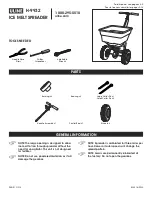
Lit. No. 31008/31021, Rev. 00
7
June 1, 2022
DETERMINING VEHICLE PAYLOAD
1. Install the hopper spreader and optional
equipment according to the Installation
Instructions.
2.
Install or attach any other equipment that will be
on the vehicle while the hopper spreader will be in
use (step bumper, trailer hitch, snowplows, etc.).
Fill fuel tanks.
3. Obtain the Gross Vehicle Weight Rating (GVWR),
Front Gross Axle Weight Rating (FGAWR), and
Rear Gross Axle Weight Rating (RGAWR) from
the certification label located inside the driver-side
door jamb or door.
WARNING
Do not exceed GVWR, GAWR, or maximum
vehicle load capacity, including the spreader
and ballast. See Loading section to determine
maximum volumes of spreading material.
4. With the occupants in the vehicle for normal
hopper spreader operation, weigh the vehicle to
obtain gross vehicle weight (GVW).
5. Subtract the GVW from the GVWR to determine
the available material payload.
6. Obtain the weight per cubic yard (lb/yd
3
) or cubic
meter (kg/m
3
) of the desired material. Divide the
weight into the payload to determine the maximum
volume of material that can be carried.
7. Refer to the Load Volume table and diagrams to
determine the maximum fill level for the material.
8.
Fill the hopper with material to the calculated level.
Reweigh the vehicle with occupants and verify that
the Loaded Gross Vehicle Weight, Front Gross
Axle Weight, and Rear Gross Axle Weight are less
than the vehicle's ratings.
9. Repeat Steps 6–8 for each type of material.
The worksheet for Determining Vehicle Payload (next
page) includes an example.
LOADING








































